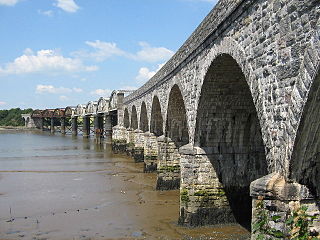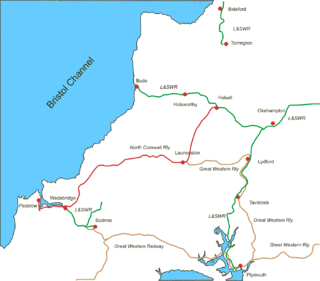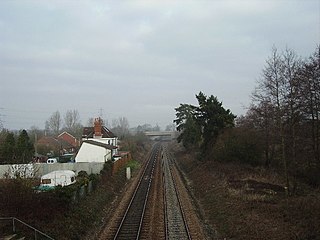
The Bodmin and Wadebridge Railway was a railway line opened in 1834 in Cornwall, England, United Kingdom. It linked the quays at Wadebridge with the town of Bodmin and also to quarries at Wenfordbridge. Its intended traffic was minerals to the port at Wadebridge and sea sand, used to improve agricultural land, inwards. Passengers were also carried on part of the line.

The Plymouth, Devonport and South Western Junction Railway (PD&SWJR) was an English railway company. It constructed a main line railway between Lydford and Devonport, in Devon, England, enabling the London and South Western Railway (LSWR) to reach Plymouth more conveniently than before.

The South Devon and Tavistock Railway linked Plymouth with Tavistock in Devon; it opened in 1859. It was extended by the Launceston and South Devon Railway to Launceston, in Cornwall in 1865. It was a broad gauge line but from 1876 also carried the standard gauge trains of the London and South Western Railway between Lydford and Plymouth: a third rail was provided, making a mixed gauge. In 1892 the whole line was converted to standard gauge only.

The Exeter and Crediton Railway was a 7 ft broad gauge railway that linked Exeter and Crediton, Devon, England. It was 5¼ miles (8½ km) long.

The North Cornwall Railway was a railway line running from Halwill in Devon to Padstow in Cornwall via Launceston, Camelford and Wadebridge, a distance of 49 miles 67 chains. Opened in the last decade of the nineteenth century, it was part of a drive by the London and South Western Railway (LSWR) to develop holiday traffic to Cornwall. The LSWR had opened a line connecting Exeter with Holsworthy in 1879, and by encouraging the North Cornwall Railway it planned to create railway access to previously inaccessible parts of the northern coastal area.
The Okehampton–Bude line was a railway line built to serve Holsworthy in Devon, and Bude on the Cornish coast near the Devon border in England. The line branched from the main line at Meldon Junction to the west of Okehampton on the northern edge of Dartmoor. The line opened in 1879 to Holsworthy and in 1898 to Bude. It is now closed.

The Exeter to Plymouth railway of the London and South Western Railway (LSWR) was the westernmost part of a route competing with that of the Great Western Railway (GWR) and its 'associated companies' from London and Exeter to Plymouth in Devon, England. Whereas the GWR route from Exeter followed the coast to Newton Abbot and then went around the southern edge of Dartmoor, the LSWR route followed the northern and western margins of Dartmoor, passing through the towns of Crediton, Okehampton, and Tavistock.
Avon Lodge was a private untimetabled railway station in the county of Hampshire, opened on 3 November 1862 by the Ringwood, Christchurch and Bournemouth Railway. Becoming part of the London and South Western Railway, it was taken into the Southern Railway in the grouping of 1923 and closed on 30 September 1935.

Halwill Junction Railway Station was a railway station in Halwill Junction, near the villages of Halwill and Beaworthy in Devon, England. It opened in 1879 and formed an important junction between the now-closed Bude Branch and North Cornwall line. It closed in 1966 along with the lines which it served, a casualty of the Beeching Report.

Bude railway station was the western terminus of the Bude Branch. It was opened in 1898 by the London and South Western Railway (LSWR) to serve the coastal town of Bude and closed in 1966 after having been proposed for closure in the Beeching Report.

Holsworthy was a railway station in Devon, England, on the now-closed railway line from Okehampton to Bude. It opened in 1879 to serve the market town of Holsworthy and closed in 1966, a victim of the Beeching Axe.

Sampford Courtenay railway station is a disused railway station at Belstone Corner, which used to serve the nearby village of Sampford Courtenay in Devon. The village lies 3 minutes away by car or around 30 minutes by foot via the B3215. In 2018–19 it was the least used station in Devon and in the South West and the tenth least used station in Great Britain. In 2020-21 it was the joint least used station in Great Britain with 0 passengers.

Bow railway station was a railway station serving the village of Bow and the hamlet of Nymet Tracy in Devon. Bow lies about 8 miles west of Crediton.

North Tawton railway station was a railway station serving the town of North Tawton in Devon, England. North Tawton lies on the River Taw.

Nursling railway station served the village of Nursling near Southampton, England.

Bridestowe railway station served the 2 miles or so distant village of Bridestowe in West Devon, England, located outside Okehampton on the edge of Dartmoor.

Dunsland Cross was a railway station on the Bude Branch that closed in 1966. Dunsland Cross station in the parish of Holsworthy was 6 miles East of the village, now town of Holsworthy. The station was opened in 1879 by the London and South Western Railway (LSWR) when Holsworthy station was the terminus of the line, some years before the route to serve the coastal town of Bude was finally opened in 1898.

Whitstone and Bridgerule was a railway station on the Bude Branch that closed in 1966. The station was opened in 1898 by the London and South Western Railway (LSWR) when the line was extended from Holsworthy station to the new terminus of the line at Bude.
Camels Head Halt railway station, named after a local public house in Plymouth, was opened as part of the city's suburban network by the London and South Western Railway in 1906, closing in 1942. It was located on the outskirts of the city in sight of the Great Western Railway main line that crossed the River Tamar by the Royal Albert Bridge.
Weston Mill Halt railway station was named after a mill and quay with its lime kiln sitting on Weston Mill Lake next to the River Tamar. The small settlement of Weston Mill also lay near by and the halt was opened as part of Plymouth's suburban network development, together with other halts such as the nearby Camels Head Halt, by the London and South Western Railway in 1906, closing in 1921 or Sunday 4 May 1942. It was located on the outskirts of the city not far from the Great Western Railway main line's Weston Mill Bridge.
















